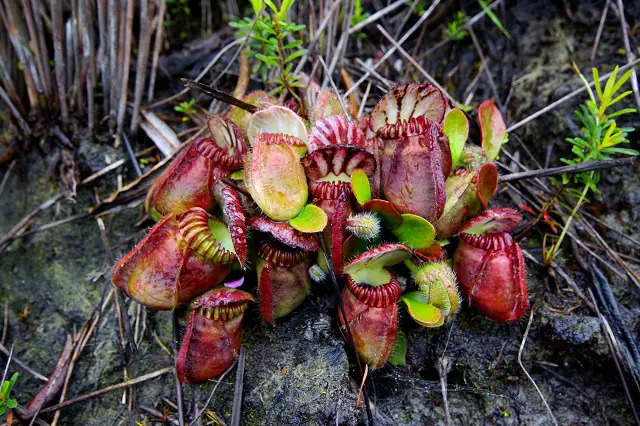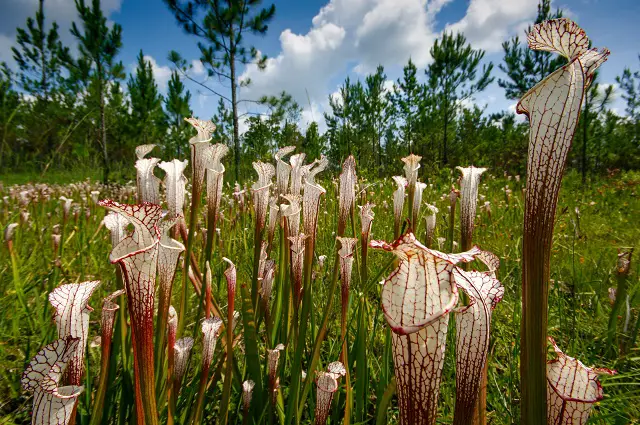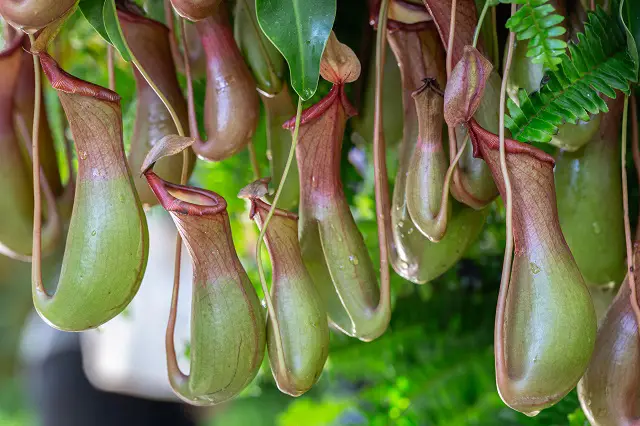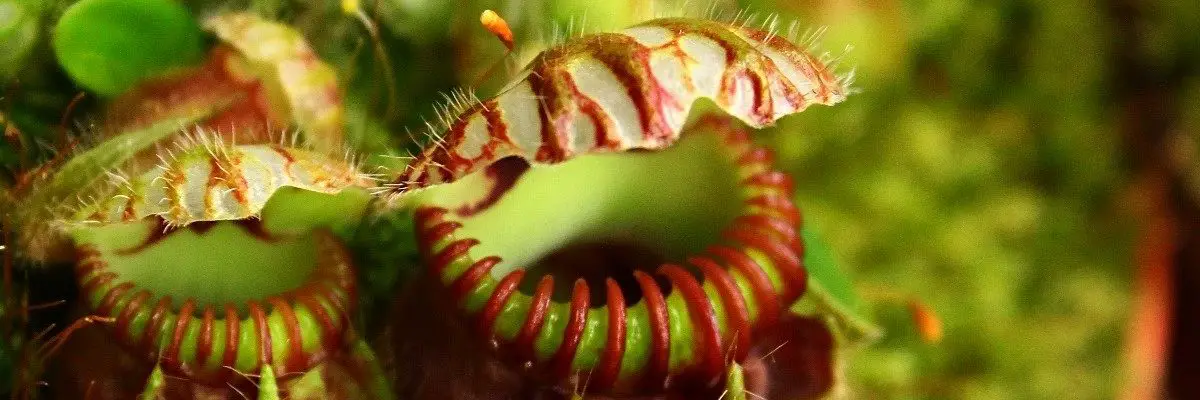Pitcher plants are carnivorous, which means that they eat insects and other small creatures.
It’s a type of plant that uses modified leaves referred to as pitfall traps to trap insects; the traps have a vase-like shape and are filled with nectar that serves as a digestion method.
Plants of this strange species possess modified leaves that form pitchers in bright colors. Due to their bright colors and intoxicating nectar, these pitchers attract a large number of insects. While searching for nectar, the insects fall into the pitcher and are trapped and digested by the plant while they are still alive.
The flowers of many of these plants are not usually grown for their beauty, but they do appear for a short period of time during spring in strong hues of pink, purple, white, yellow, and red. Some of the flowers may even resemble an upside-down umbrella. While some varieties have a pleasant smell, a few varieties have a strong odor reminiscent of cat urine.
Why do Pitcher Plants Eat Insects?
A carnivorous plant is a plant that derives some or most of its nutrients from trapping and ingesting animals and protozoa, usually insects and other arthropods, as their nutrients.
In spite of the fact that they eat insects for food, carnivorous plants also produce some of the energy they need from photosynthesis.
Among the many different types of carnivorous plants that exist, many are adapted to flourish in environments that are deficient in nutrients. For example, acidic bogs have thin soil and low nitrogen levels.
A common feature among all carnivorous plants is the very poor and almost lifeless soil in which most normal plants would struggle even to survive, let alone grow and be healthy.
In normal conditions, As decaying plants and animal matter in the soil are readily consumed by healthy populations of bacteria; essential nutrients become available to the plants to eat.
In certain habitats, however, soil bacteria are unable to thrive, causing them to have difficulty completing their jobs. In many cases, saturated soils can be prevented from absorbing adequate oxygen, and they are also described as wetland deserts when they contain excessive amounts of moisture.
What Are The Different Types Of Pitcher Plants?
Cephalotaceae
Despite having most of its “traditional” leaves, pitcher plants also have modified leaves, which serve as pitfall traps for insects and other small prey species.
A hairy red and white-striped lid protects the carnivorous leaves from rain, thus preventing water from flowing into the pitchers where the carnivorous leaves are arranged.
It is also believed that the color of the lid and patches of semitransparent tissue on the surface attract prey and exhaust insects that are flying inside the trap.
A distinctive feature of this pitcher is the presence of several smooth, dark red rings, which act as an attractive nectar source and prevent climbing insects, primarily ants, from climbing out.

Sarraceniaceae
In North America, a family of pitcher plants known as Sarraceniaceae consists of three genera found across the entire continent.
It is common for members of this family to inhabit habitats such as swamps, bogs, wet meadows, and savannas, with wet, acidic soils lacking in nutrient content.
Several species of Sarracenia are found in eastern North America. Sarracenia is sometimes referred to as the trumpet pitcher genus due to its trumpet-shaped leaves and trumpet-shaped flowers.
A nectar-secreting trail is present along the lip of the pitcher that attracts insects and other prey to the mouth. These glands extend downward along the lip to the interior of the pitcher, enticing them to come close to the mouth of the pitcher.
In the throat of the pitcher, just below the lip, is a very smooth surface, which causes the insects to slip down into the pool of liquid at the bottom of the pitcher, where they will drown.

Nepenthaceae
There are approximately 140 species of pitcher plants in the family Nepenthaceae, native to Madagascar, South East Asia, and Australia. Nepenthes, the genus, is comprised of just one species.
Several of them are perennial plants that grow in very acidic soils. Still, some of them are epiphytic and live on tree branches.
The cap of the pitcher secretes nectar to attract prey to the trap, as it has downward-pointing hairs on the surface and slick sides that prevent the prey from escaping the trap.
It includes the critically endangered Attenborough’s pitcher plant (Nephrocaulon Attenborough), a carnivorous palm that can grow up to 1.5 meters (4.9 feet) tall and whose pitchers can reach a diameter of 30 cm (11.8 inches), which makes it one of the largest plants in the world.

Do Pitcher Plants Flower?
As the waxy flower opens, its single stem turns upside down, and the petals begin to unfurl as the flower opens. There is a great deal of interest in the waxy flower, not only for its beauty but also for its duration.
Many pitcher plants flower in early spring before fully developing their leaves. Observing maroon, red, pink, acid yellow, or green petals for about a week after the flower has opened is possible.
In this case, bumblebees are the pollinators, one of the few strong enough insects to force their way into the flower’s interior and pollinate it.
The seed pods, which remain behind after the petals drop and the rest of the floral structure, continue to flourish throughout the rest of the season, adding even more interest to these gorgeous plants.


